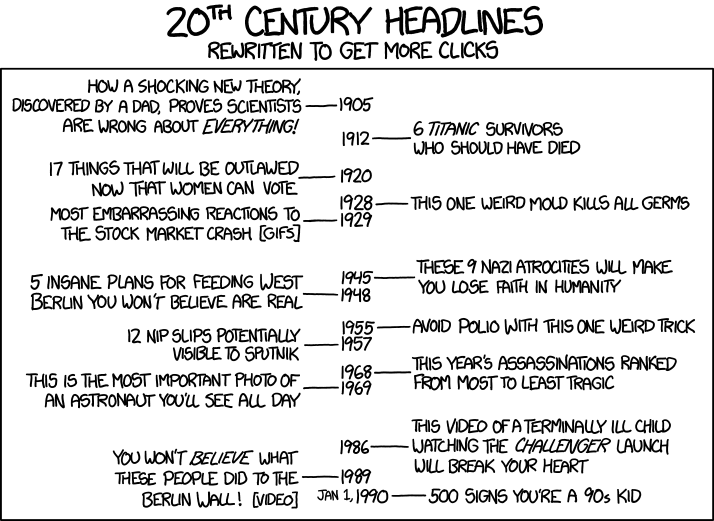Creativity
How Content Marketers Can Use the Power of Clickbait for Good
By Nicola Brown on March 21, 2018
It's hard to go anywhere on the Internet today without running into clickbait titles trying to entice you down the digital rabbit hole. One minute you're looking up how to watch the Oscars online and the next you're watching videos of cats being scared by cucumbers.
These clickbait titles can catch you off guard in search results and on the side of reputable news sites. In most cases, the purpose of clickbait headlines is not to entice you to read a particularly valuable story; it's simply to bring in clicks and advertising revenue. Many creators of clickbait content couldn't care less about the substance of the thing you're clicking on; their sole job is to get you to click.
As much as we're aware of this as marketers, sometimes even our curiosity gets the better of us. Maybe there is a cool new health or financial trick we could learn, and what does that celebrity's bathroom really look like, or maybe we could just really do with a dose of ducks wearing bow ties right now.
The overwhelming prevalence of clickbaity headlines raises some very important questions for marketers and strategists trying to find the right balance: What is more important for brand publishers-revenue or reputation? Can we take advantage of our must-click curiosity in an ethical way?
Image attribution: xkcd
The Psychology behind Clickbait
Even when we know we're staring at a clickbait headline, we still feel compelled to click it. This is some seriously powerful psychology-so how does it work? What's actually going on in our brains that makes clickbait so tempting?
Researchers have discovered many linguistic, visual, and emotional mechanisms at work behind the curiosity-inducing headlines. Here are some of the features that draw us in:
Empty or Unresolved Pronouns
This Is the Only Photo You Need to See Today. We are lured in by the information gap because we want to know what the unresolved pronoun "this" is referring to.
Affective and Suspenseful Language
You'll Never Guess What Happened Next. This kind of suspenseful storytelling technique is simple and effective. It makes us wonder, what could this outcome possibly be that I could never guess?
Action Words
Look How Much This Dog Hates Baths. In this example, the word "look" is an imperative command.
Overuse of Numerals
15 Former Stars Who Now Work Regular Jobs. Believing we are getting a lot of stuff in a short amount of time makes the effort of clicking seem worth it. Odd numbers tend to attract more clicks.
Reverse Narratives
Doctors Say This One Herb Prevents Hair Loss. Is It True? Reverse narratives refer to when the normal linear plot of a story is told backwards, or the punch line is revealed first. We're given the crux of the issue; now we want to know the backstory.
Incongruent Images with Emotional Load
8 Things You Probably Never Knew About Your Bank Account. Imagine this headline accompanied by an image of a celebrity looking angry. This mismatch works two-fold: First, we're compelled to correct the mismatch by clicking to find out what the headline and the image have to do with each other, and second, we're drawn in by the emotional load of the image-why are they so angry? What happened?
Image attribution: Brian Kndeneh
If you understand the psychology of the "bait," you can appreciate how clickbait successfully drives revenue through "clicks."
But marketers and content creators have more than just clicks and revenue to consider. Because of the reach of today's organizations into every corner of our lives through digital technology, we have a responsibility to ensure we are reaching our audience ethically. This is true not just in the interest of long-term loyalty and authentic brand image but also for our own sanity and the kind of online world we want to live in.
At the end of the day, it's also a question of ROI. Are we ensuring that the pageviews we're driving are coming from the right audiences and that they will lead to further engagement with our content and our brands?
Engaging in ethical marketing is the long-game strategy that will distinguish successful brands and publishers-but that doesn't mean we can't borrow some clickbait-style tactics for our content.
4 Tactics for Using Clickbait Psychology in an Ethical Way (#2 Is Awesome!)
1. Use Clickbait Tactics to Link to Other Relevant Articles on Your Site
Internal linking within your own website is good SEO practice, and it also encourages your readers to spend more time on your site. You can add links to relevant content within an article in a "recommended" segment or add a few links (with photos) at the end of your article to other relevant content on your site. Using clickbait tactics here is ethical because you're not trying to trick your readers into clicking so you can make revenue off ad impressions. You're simply encouraging them to explore more of the content on your site.
2. Use Clickbait Features in Moderation
Note the difference between 27 Unbelievable Marketing Tactics You'll Use EVERY. SINGLE. DAY!!! and 7 Unexpected Marketing Tactics You'll Use Every Day. The first would be inappropriate for most company blogs; the second is a much more professional version that still makes use of numeration and affective language, two of the features that make clickbait headlines so compelling. Using clickbait tactics in moderation can encourage your audience to explore your content while ensuring you retain your reputable brand image.
3. Use Clickbait-Style Content Humorously
Humor is a valuable tool for establishing a positive emotional connection with your audience. By now, audiences are generally aware of the telltale signs of a clickbait headline, so play on this shared knowledge by using clickbait content humorously. Let your audiences laugh alongside you at how ridiculous the trend is, and use it to establish trust and connection. One of the most important things you can do with your brand's content is give your audience credit for being educated, savvy content consumers just like you.
4. Make Sure You Have Variety in Your Content
Even if you are using clickbait tactics in an ethical way, too much of one thing is never a good thing. Vary the type of content you publish and the kinds of formats and tones you use in different pieces. Know when and where it's appropriate and beneficial to employ a less formal approach (blogs or newsletters) and when and where it's not (white papers or case studies).
For more stories like this, subscribe to the Content Standard newsletter.
Featured image attribution: Nubia Navarro



